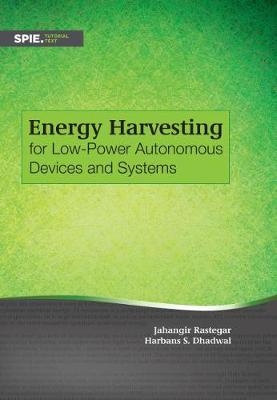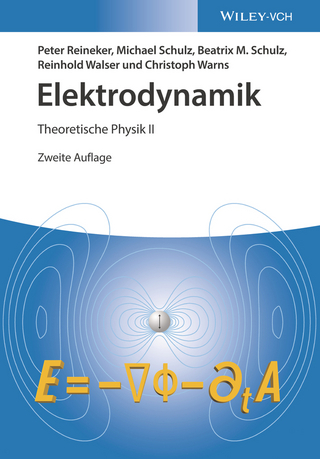
Energy Harvesting for Low-Power Autonomous Devices and Systems
SPIE Press (Verlag)
978-1-5106-0490-2 (ISBN)
- Keine Verlagsinformationen verfügbar
- Artikel merken
This book is an introductory text describing methods of harvesting electrical energy from mechanical potential and kinetic energy. The book focuses on the methods of transferring mechanical energy to energy conversion transducers of various types, including piezoelectric, electromagnetic, electrostatic, and magnetostrictive transducers. Methods that have been developed for collecting, conditioning, and delivering the generated electrical energy to a load, as well as their potential use as self-powered sensors, are described. The book should be of interest to those who want to know the potentials as well as shortcomings of energy harvesting technology. The book is particularly useful for energy harvesting system designers as it provides a systematic approach to the selection of the proper transduction mechanisms and methods of interfacing with a host system and electrical energy collection and conditioning options. An extensive bibliography is provided to direct the reader to appropriate references for detailed material not included in the book.
Preface
1 Energy Harvesting
1.1 Introduction
1.2 Thermal-to-Electrical-based Energy Harvesting
1.3 Solar-to-Electrical-based Energy Harvesting
1.4 Radio-Frequency-to-Electrical-based Energy Harvesting
1.5 Sources of Energy from Human Activity
1.6 Mechanical-to-Electrical-based Energy Harvesting
References
2 Mechanical-to-Electrical Energy Conversion Transducers
2.1 Introduction
2.2 Piezoelectric Transducers
2.2.1 Polycrystalline piezoelectric ceramics
2.2.2 Piezoelectric polymers and polymer-ceramic composites
2.2.3 Single-crystal piezoelectric ceramics
2.2.4 Lead-free piezoelectric materials
2.2.5 Piezoelectric materials for high-temperature applications
2.2.6 Other piezoelectric material types and structures
2.3 Electromagnetic Induction Transducers
2.4 Electrostatic Transducers
2.4.1 Electret-based electrostatic transducers
2.5 Magnetostrictive-Material-based Transducers
2.6 General Comparison of Different Transducers
2.7 Transducer Shelf Life and Operational Life
References
3 Mechanical-to-Electrical Energy Transducer Interfacing Mechanisms
3.1 Introduction
3.2 Interfacing Mechanisms for Piezoelectric-based Transducers
3.2.1 Interfacing mechanisms for potential energy sources and continuous rotations
3.2.2 Interfacing mechanisms for continuous oscillatory translational and rotational motions
3.2.3 Interfacing mechanisms for periodic oscillatory translational and rotational motions of the host system
3.2.4 Interfacing mechanisms for oscillatory translational and rotational motions with highly varying frequencies and random motions
3.2.5 Interfacing mechanisms for energy harvesting from shortduration force and accelerating/decelerating pulses
3.3 Design of DOEs using Algorithms
3.2.1 Design procedure of DOEs using IFTA
3.3 Interfacing Mechanisms for Electromagnetic-based Transducers
3.3.1 Interfacing mechanisms for rotary input motions
3.3.2 Interfacing mechanisms for continuous oscillatory translational and rotational motions
3.3.3 Interfacing mechanisms for energy harvesting from shortduration force and acceleration pulses
3.4 Interfacing Mechanisms for Electrostatic- and Magnetostrictive-based Transducers
References
4 Collection and Conditioning Circuits
4.1 Introduction
4.2 Collection and Conditioning Circuits for Piezoelectric Transducers
4.2.1 Direct rectification and conditioning methods
4.2.2 Circuits to maximize harvested energy
4.2.3 Collection circuits
4.2.4 Conditioning circuits
4.2.5 CC circuits for pulsed piezoelectric loading
4.3 Collection and Conditioning Circuits for Electromagnetic Energy Harvesters
4.3.1 Synchronous magnetic flux extraction
4.3.2 Active full-wave rectifier
4.4 Collection and Conditioning Circuits for Electrostatic Energy Harvesters
4.4.1 Electret-based eEHs
4.4.2 Active conditioning circuits
4.4.3 Electret-free eEHs
4.5 Conditioning Circuits for Vibration-based Magnetostrictive Energy Harvesters
References
5 Case Studies
5.1 Introduction
5.2 Commercial Vibration Energy Harvesters
5.2.1 IC products for energy-harvesting devices
5.3 Tire Pressure Monitoring System
5.4 Self-Powered Wireless Sensors
5.5 Piezoelectric Energy-Harvesting Power Sources for Gun-Fired Munitions and Similar Applications
5.6 Self-Powered Shock-Loading-Event Detection with Safety Logic Circuit and Applications
5.6.1 Self-powered shock-loading-event-detection and initiation device
5.6.2 Shock-loading-event-detection switching applications
References
Index
| Erscheinungsdatum | 11.01.2017 |
|---|---|
| Reihe/Serie | Tutorial Texts |
| Verlagsort | Bellingham |
| Sprache | englisch |
| Maße | 152 x 229 mm |
| Gewicht | 525 g |
| Themenwelt | Naturwissenschaften ► Physik / Astronomie ► Elektrodynamik |
| Technik ► Elektrotechnik / Energietechnik | |
| Technik ► Maschinenbau | |
| ISBN-10 | 1-5106-0490-1 / 1510604901 |
| ISBN-13 | 978-1-5106-0490-2 / 9781510604902 |
| Zustand | Neuware |
| Haben Sie eine Frage zum Produkt? |
aus dem Bereich


